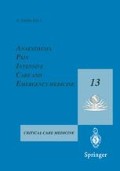Abstract
Despite great variability in water and electrolyte intake, circulating intravascular volume, electrolyte composition of various body fluids, and serum osmolality remain remarkable constant in health.
Access this chapter
Tax calculation will be finalised at checkout
Purchases are for personal use only
Preview
Unable to display preview. Download preview PDF.
References
Marini JJ, Wheeler AP (1997) Fluid and electrolyte disorders. In: Zinner SR (ed) Critical care medicine the essentials, 2nd edn vol. 13. Williams and Wilkins, pp 223–240
Koch SM, Taylor RW (1992) Chloride ion in intensive care medicine. Crit Care Med 20(2):227–240
Kruse JA, Carlson EW (1990) Rapid correction of hypokalemia using concentrated intravenous chloride infusions. Arch Intern Med 3:529
Brown RS (1986) Extrarenal potassium homeostasis. Kidney Int 30:116
Zaloga GP, Chernow B (1988) Divalent ions-calcium, magnesium and phosphorus. In: Chrnow B (ed) The pharmacologic approach to the critically ill patient, 2nd edn. Williams and Wilkins, Baltimore, pp 603–636
Ladenson JH, Lewis JW, Boyd JC (1978) Failure of total calcium corrected for protein, albumin, and pH to correctly assess free calcium status. J Clin Endocrinol Metab 46:986–993
Burg MB, Green M (1973) Function of the thick ascending limb of Henle’s loop. Am J Physiol 224:659–668
Klahr S, Weiner ID (1990) Disorders of acid-base metabolism. In: Chan JC, Jill JR (eds) Kidney electrolyte disorders. Churchill Livingstone, New York, pp 1–58
Halperin ML, Goldstein MB (1988) Fluid, electrolyte, and acid-base emergencies. WB Saunders, Philadelphia, pp 163, 239–241, 290–293
Harrington JT, Cohen JJ (1975) Measurement of urine electrolytes-Indications and limitations. N Engl J Ned 293:1241–1243
Goldstein MB, Bear R, Richardson RMA et al (1986) The urine anion gap: A clinically useful index of ammonium excretion. Am J Med Sci 292:198–202
Oh MS, Carrol W (1977) The anion gap. N Engl J Med 297:814–817
Kunau RT, Stein JH (1977) Disorders of hypo and hyperkalemia. Clin Nephrol 7:173–190
List A (1991) Malignancy hypercalcemia: Choice of therapy. Arch Intern Med 154:437
Roswell RH (1987) Severe hypercalcemia: Causes and specific therapy. J Crit Illness 2:14
Baldwin TE, Chernow B (1987) Hypocalcemia in the ICU: Coping with the causes and consequences. J Crit Illness 2:9
Chernow B, Bamberger S, Stoiko M et al (1989) Hypomagnesemia in patients in postoperative intensive care. Chest 95:391–397
Ryzen E, Wgers PW, Singer FR et al (1985) Magnesium deficiency in a medical ICU population. Crit Care Med 13:19–21
Reinhart RA (1988) Magnesium metabolism: A review with special reference to the relationship between intracellular content and calcium levels. Arch Intern Med 148:2415
Knocher JP (1977) The pathophysiology and clinical characteristics of severe hypophosphatemia. Arch Intern Med 137:203–220
Author information
Authors and Affiliations
Editor information
Editors and Affiliations
Rights and permissions
Copyright information
© 1999 Springer-Verlag Italia
About this paper
Cite this paper
Bobbio Pallavicini, F., Verde, G., Tosi, P. (1999). Fluid and Electrolyte Management in Intensive Care. In: Gullo, A. (eds) Anaesthesia, Pain, Intensive Care and Emergency Medicine — A.P.I.C.E.. Springer, Milano. https://doi.org/10.1007/978-88-470-2145-7_39
Download citation
DOI: https://doi.org/10.1007/978-88-470-2145-7_39
Publisher Name: Springer, Milano
Print ISBN: 978-88-470-0051-3
Online ISBN: 978-88-470-2145-7
eBook Packages: Springer Book Archive

